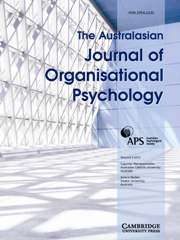Crossref Citations
This article has been cited by the following publications. This list is generated based on data provided by
Crossref.
Peleg, Kobi
Bodas, Moran
Shenhar, Gilead
and
Adini, Bruria
2018.
Wisdom of (using) the crowds: Enhancing disasters preparedness through public training in Light Search and Rescue.
International Journal of Disaster Risk Reduction,
Vol. 31,
Issue. ,
p.
750.
Chacón-Cuberos, Ramón
Castro-Sánchez, Manuel
Pérez-Turpin, José Antonio
Olmedo-Moreno, Eva María
and
Zurita Ortega, Félix
2019.
Levels of Physical Activity Are Associated With the Motivational Climate and Resilience in University Students of Physical Education From Andalucía: An Explanatory Model.
Frontiers in Psychology,
Vol. 10,
Issue. ,
Naeem, Rana Muhammad
Weng, Qingxiong (Derek)
Hameed, Zahid
and
Rasheed, Muhammad Imran
2020.
Ethical leadership and work engagement: A moderated mediation model.
Ethics & Behavior,
Vol. 30,
Issue. 1,
p.
63.
Kaim, Arielle
Jaffe, Eli
Siman-Tov, Maya
Khairish, Ella
and
Adini, Bruria
2020.
Impact of a Brief Educational Intervention on Knowledge, Perceived Knowledge, Perceived Safety, and Resilience of the Public During COVID-19 Crisis.
International Journal of Environmental Research and Public Health,
Vol. 17,
Issue. 16,
p.
5971.
McArthur, Michelle L.
Learey, Tobi J.
Jarden, Aaron
Van Gelderen, Ingrid
Hazel, Susan J.
Cake, Martin A.
Mansfield, Caroline F.
Zaki, Sanaa
and
Matthew, Susan M.
2021.
Resilience of veterinarians at different career stages: The role of self‐efficacy, coping strategies and personal resources for resilience in veterinary practice.
Veterinary Record,
Vol. 189,
Issue. 12,
Uppathampracha, Rachadatip
and
Liu, Guoxin
2022.
Leading for Innovation: Self-Efficacy and Work Engagement as Sequential Mediation Relating Ethical Leadership and Innovative Work Behavior.
Behavioral Sciences,
Vol. 12,
Issue. 8,
p.
266.
Malmgren Fänge, Agneta
Christensen, Jonas
Backhouse, Tamara
Kenkmann, Andrea
Killett, Anne
Fisher, Oliver
Chiatti, Carlos
and
Lethin, Connie
2022.
Care Home and Home Care Staff’s Learning during the COVID-19 Pandemic and Beliefs about Subsequent Changes in the Future: A Survey Study in Sweden, Italy, Germany and the United Kingdom.
Healthcare,
Vol. 10,
Issue. 2,
p.
306.
EROĞLU, Şeyma Gün
and
KOCA, Mehmet Kürşat
2023.
COVID-19 pandemisi döneminde sosyal bilgiler öğretmenlerinin öz-yeterlilik algıları ve psikolojik dayanıklılıklarının psikolojik iyi oluşları üzerindeki etkilerinin incelenmesi.
Balıkesir Üniversitesi Sosyal Bilimler Enstitüsü Dergisi,
Vol. 26,
Issue. 50,
p.
541.
Kho, Madison C.
Karin, Eyal
Gucciardi, Daniel F.
and
Crane, Monique F.
2023.
Testing a supervisor‐led extension of self‐reflection resilience training: A controlled trial randomized by platoon at the Royal Military College.
Journal of Occupational and Organizational Psychology,
Vol. 96,
Issue. 2,
p.
397.
Mittelstädt, Justin Maximilian
Hörmann, Hans-Jürgen
Oubaid, Viktor
and
Soll, Henning
2024.
The Role of Basic Flight Simulators in the Selection of Ab Initio Airline Pilots.
The International Journal of Aerospace Psychology,
p.
1.




